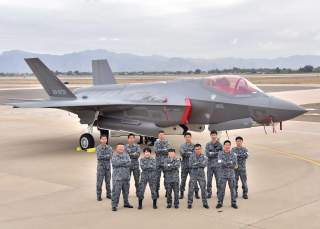This Photo Has China's Military Scared Stiff (Japan Now Has the F-35)
Japan just got the F-35.
Japan’s first Lockheed Martin F-35 Joint Strike Fighter arrived at Luke Air Force Base in Arizona yesterday.
For the Japanese Air Self-Defense Force (JASDF), the arrival of the new jet at Luke AFB marks the beginning of a transition towards an air arm equipped with a potent fifth-generation stealth fighter capability that will enable Tokyo to counter the rising threat from China. Under the foreign military sales (FMS) agreement with Tokyo, the United States Air Force will train Japanese pilots to fly and fight in the F-35 under the auspices of the reserve component 944 Fighter Wing and the active component 56th Fighter Wing.
“Today I am thrilled for the Japan Air Self-Defense Force and Team Luke,” Lt. Col. Sean Holahan, 944th Operations Group Detachment 2 commander, said in a statement. “The arrival of Japan’s first F-35A marks another important milestone in the steadfast relationship between our two nations, and the beginning of training for an elite cadre of JASDF fighter pilots and maintainers. We put an incredible amount of thought and effort into building the world’s first F-35 Foreign Military Sales training program from the ground up. To see Japan’s first jet on our flightline, surrounded by the men and women who have made this mission possible, is humbling.”
This first Japanese jet was rolled out of the Lockheed plant in Fort Worth, Texas, on Sept. 23, 2016, as one of four Japanese F-35s that will be assembled in the United States. The remaining 38 Japanese F-35s will be assembled in Nagoya, Japan.Japan’s pilots and maintainers are the first FMS customers to start training on the F-35 at Luke AFB. Previous foreign JSF pilots and maintainers trained in the United States have been partners on the F-35 program.
“The jet arrival marks the beginning of a new and exciting mission at Luke AFB to train our allies to fly the F-35A,” Lt. Col. Joe Bemis, 944 OG Det. 2 executive officer and resource advisor, in a statement. “We have been preparing for this program for years. We have remodeled buildings, built a huge team of professional pilots, maintainers, and administration staff, and created specialized syllabus. We are hopeful that this mission will strengthen relationships between the U.S. and nations that participate in the training.”
The addition of the F-35 to the Japanese arsenal should significantly boost Tokyo’s airpower capacity. With the Chinese People’s Liberation Army Air Force and Navy rapidly modernizing with advanced new surface-to-air missiles and new fourth-generation aircraft such as the J-15 and J-16, Japan’s fleet of McDonnell Douglas F-4EJ Phantom II, Boeing F-15J Eagles and Mitsubishi F-2 fighters are increasingly challenged to defend the island nation and strike back.
Indeed, while the F-35 will eventually be an adequate air-to-air fighter with its combination of stealth, sensors and networking, the jets’ true strength is its ability to strike inside heavily defended airspace. The ability to strike inside such anti-access/area-denial (A2/AD) bubbles will become increasingly important as China starts to receive advanced new weapons such as the Russian S-400. Thus, the Japan’s purchase of the F-35 should help to deter Chinese adventurism in the region.
Dave Majumdar is the defense editor for the National Interest. You can follow him on Twitter: @davemajumdar.
Image Credit: U.S. Department of Defense.

